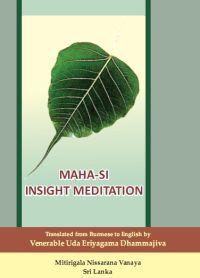
Insight Meditation by Mahasi Sayadaw. Mahasi was a leading figure the revival of Buddhism in Burmas post-independence period, a movement that established many centers for teaching insight meditation. The Mahasi method is designed to allow lay people in the modern world to attain the experience of enlightenment, or nibbana. Vipassana meditation in this tradition is also known as ‘mindfulness meditation‘ for its practice of continuous and unremitting attention to mental and physical phenomena as they appear to the meditator.
Insight Meditation here (880KB/162 pages – from now on, I will include the size of all books here, by request from a reader from a remote Pacific Island with a limited Internet connection:
 Insight Meditation
Insight Meditation
You can buy the print books by Mahasi Sayadaw here: Link
What is Insight Meditation in Buddhism?
Insight Meditation, often called “Vipassana” in the Pali language, is a central practice in Theravada Buddhism. The term “Vipassana” can be translated as “clear seeing” or “insight.” The practice aims to cultivate a deep and penetrative understanding of the true nature of reality. Here are some key points about Insight Meditation:
- Objective: The primary objective of Vipassana is to gain insight into the three marks of existence: impermanence (anicca), suffering (dukkha), and the absence of a permanent self (anatta).
- Mindfulness: Vipassana emphasizes cultivating mindfulness (sati) – a keen awareness of what is happening in the present moment. This involves observing sensations, thoughts, and emotions without attachment or aversion.
- Observation: Practitioners are encouraged to observe their experiences without judgment, allowing them to see things as they truly are. This observation often begins with the breath or bodily sensations and then extends to thoughts, emotions, and external stimuli.
- Retreats: While Vipassana can be practiced daily, many practitioners attend dedicated retreats. These retreats, lasting from a few days to several months, provide an environment conducive to deep meditation and introspection.
- Techniques: There are various techniques within the Vipassana tradition, but most involve focusing on the breath, bodily sensations, or the noting of thoughts and emotions as they arise.
- Benefits: Regular practice of Insight Meditation can lead to increased mindfulness, equanimity, and a deeper understanding of oneself and the world. Over time, this understanding can lead to the uprooting of mental defilements and, ultimately, enlightenment (nibbana).
- Origins: Vipassana is believed to be the meditation technique taught by the Buddha himself. It has been preserved in the Theravada tradition and has gained significant popularity worldwide, especially in the form of 10-day retreats introduced by teachers like S.N. Goenka.
- Difference from Samatha: Another significant meditation practice in Buddhism is Samatha (concentration meditation). While Samatha focuses on developing concentration and tranquility by focusing on a single object (like the breath or a mantra), Vipassana focuses on developing insight through the direct observation of one’s own experiences.
In recent decades, Vipassana has gained global recognition, with many non-Buddhists also taking up the practice for its psychological and health benefits.

Dear Dhamma Brother/ Sister,
I am a meditator and have been inspired by The chronicles of the Buddhas books. I had a copy earlier which I gave my friend to inspire her to meditate regularly.
I hereby request you to please send me a hardcopy of all the volumes if possible. I want to read them once again and keep them in my personal collection of Dhamma books.
I have the pdf version but its not feasible for me as I sit work on the computer for 9-10 hrs daily.
I serve at Global Vipassana Pagoda, Mumbai.
much metta,
Nainish